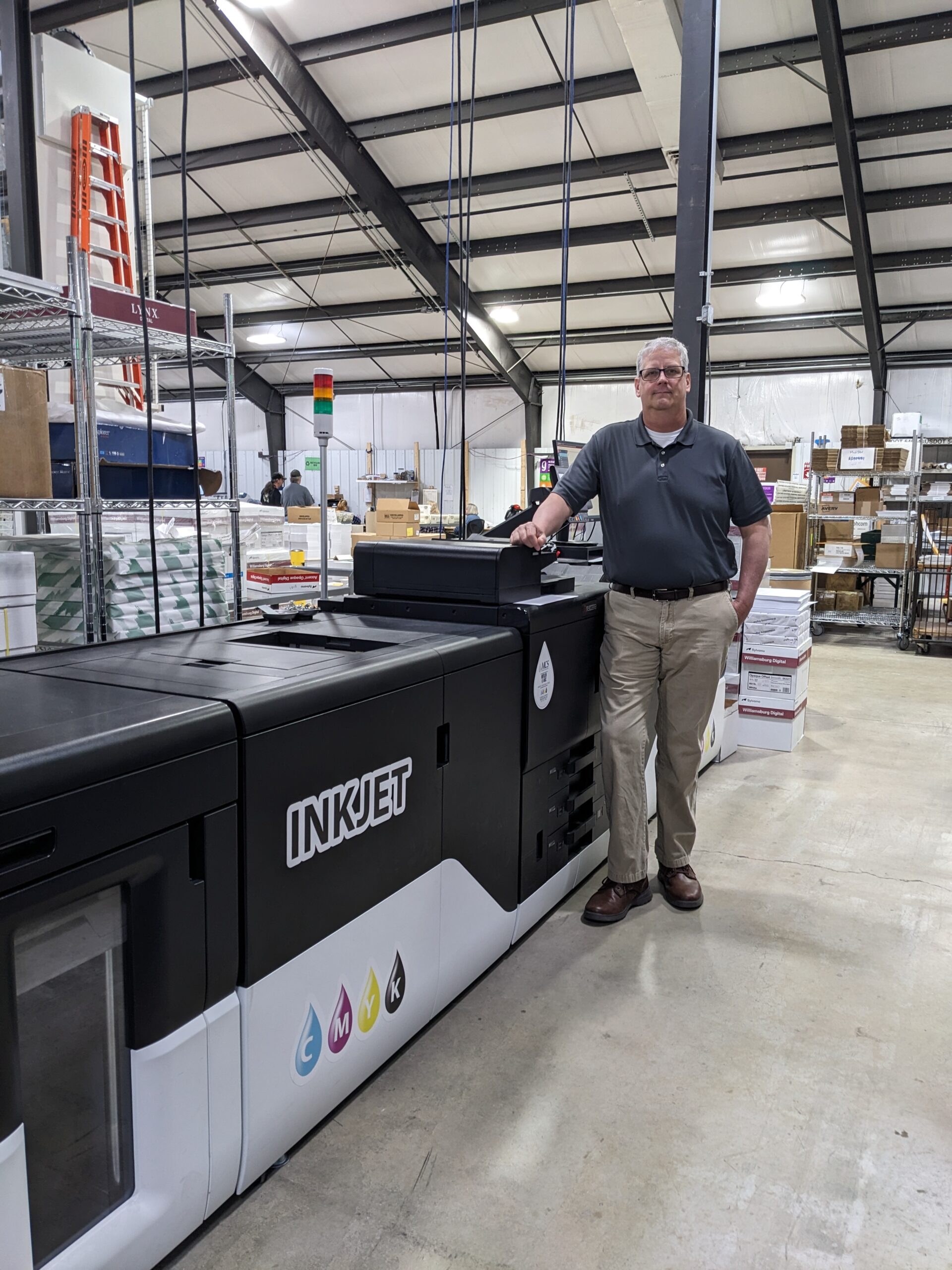Sponsored by Kyocera
Graphcom is a multi-channel marketing firm that prides themselves equally on their creative skills and their production prowess. Until recently, the Pennsylvania-based company used a combination of offset, toner and dye sublimation to support marketing services as wide ranging as direct mail, custom signage, and custom fabric printing. In 2021 several factors combined to drive Graphcom toward new technology; their toner contracts were due for renewal, print volumes were growing, and client’s service level agreements were getting shorter. The time was right to look at inkjet.
Mike Beatty, Director of Operations for Graphcom said, “We do a lot of work in the secure healthcare space and for non-profit fundraising where our SLAs have gotten shorter. Three or four years ago, if you gave me a job for 300,000 duplex sheets to run on toner, that would keep me up at night wondering if we were going to make it.”
Graphcom’s stress-relieving solution was to invest in three Kyocera TASKalfa Pro 15000c presses from long-time Kyocera partner MCS of Gaithersburg, Maryland. MCS has been selling and supporting the press under the brand Merlin K146c since 2020. Now, all but two of Graphcom’s toner machines have been retired, and Mike can sleep at night. “With the Kyocera presses, we’re now taking on work for three-quarters of a million pages, and I don’t even have to think about it anymore.”
MCS and Kyocera Partnership
MCS, founded in 1991, began by marketing mailing and pre-sorting software. For over a decade, Kyocera has been working with MCS supplying them with its industry-leading piezo inkjet technology, and since 2019, Kyocera has powered the MCS Merlin K146c with technology, which can be found in its acclaimed TASKalfa Pro 15000c. Upon its release, David Loos, President of MCS stated “this is a game changer”, and for Graphcom, that’s certainly been the case.
 Getting acclimated to inkjet
Getting acclimated to inkjet
When the Graphcom team started evaluating their inkjet options they knew that they wanted a sheet-fed solution and were focused on replacing an aging five color toner machine. In their mind, that meant a B2 format press. Further analysis showed that the highest growth and profit potential lay in full-color letter mail where a 600 dpi press would suffice. While they still had a quality threshold to meet with their customers, the focus of their inkjet evaluation shifted to speed, cost, and flexibility.
Beatty thought it was lucky that they heard about Kyocera’s inkjet technology. Not long after a fellow MCS customer installed their first press, they saw the press for the first time. He said, “The other inkjet presses we were looking at probably cost about four times what the Kyocera does, and the running cost is close to eight times what the Kyocera is. My boss looked at the speed and the cost of the TASKalfa Pro 15000c and had the insight about the work that was coming at us to know that this was a great fit.” Rather than trying to transition five-color work onto a four-color press, Graphcom has used their inkjet presses to rapidly grow the most profitable segments of their business. After only three years, Graphcom is running close to 60% of their volume on the Kyocera machines. Beatty shared that, “in terms of revenue it’s more like 70%.” With their transition to inkjet, Graphcom has been able to drive up both their revenue and profit margin.
Through MCS, Graphcom invested in their first TASKalfa Pro 15000c in May 2021 to “test the water.” Based on that experience, they purchased a second press five months later, and another just four months after that. The first press was in production within three days and the second and third presses took only two days to come online. After sending operators to a week of training at MCS, almost all maintenance is performed by Graphcom staff. Beatty was enthusiastic, “They set up a nice maintenance schedule. We know what parts to have on hand and when to replace them. I think the training was key.”
Beatty notes that most service questions are handled over the phone. He adds, “I do regularly have them (MCS) come in just to go through the machines and do some things that maybe we’re not quite familiar with, but it’s never been because the machine’s not functioning. So that has been huge.”
Graphcom was already staffed with color experts familiar with multiple print technologies and fully aware that inkjet color is different. Beatty noted that the customer they visited did not have anyone managing color for the press. Beatty said, “That’s not our space. That’s not how we play. We have the colors as dialled in as they can be.” Graphcom primarily uses inkjet treated paper and their color experts create color profiles for every stock to get the best out of the press which has a resolution of 600 x 600 dpi at full speed, or 600 x 1200 dpi at a reduced speed.
Beatty said it was fairly easy to wean most of the customers off the “shiny toner” that they were used to. Graphcom had one particularly demanding customer running jobs across offset and digital equipment. That customer had been switching print suppliers every few months because they were not happy with color matching and consistency. Beatty said, “We got all their colors dialled in across processes, except the red was a little off on the inkjet. It took a little while to convince them, but they decided they could forego the exact red because all the other colors looked great.” Once the exact color matching discussion was out of the way, the client was very pleased about the consistency of color from run-to-run and month-to-month. “Our customers know that we can hold a color. That’s another good thing about the Kyocera, you don’t have to mess with it very much. We still check the measurements every month, but generally it passes and we’re back to the races. Not like toner at all.”
Profitable Growth
Graphcom reports that the first TASKalfa Pro 15000c installed three years ago has logged almost 48 million pages and is averaging over 1.3 million images every month. Beatty calculated that, in the years that Graphcom has been running their Kyocera presses, the all-in cost including labor comes to just over a penny per letter image. For toner, the “click charge” alone was three cents. That’s before factoring in the impact of higher up-time and speed. By shifting volume from toner presses to the Kyocera inkjet presses, Graphcom has cut their digital running costs by more than two thirds.
The Kyocera TASKalfa Pro 15000c runs at 148 pages per minute which is 50% faster than the toner presses that were replaced. Beatty needs that productivity, “We typically run 16 hours per day. We just finished up two weeks where we ran 24 hours straight every day. In those two weeks we ran two million pages across those three machines using two operators per shift.” Due to space limitations at the time of purchase, only one of the TASKalfa Pro 15000c’s was configured with the maximum stacker and feeder options available. “With additional stackers and feeders, we could increase our productivity by 10% at least,” Beatty estimated.
Recently, Graphcom acquired a new facility with room for more presses as well as adding stackers and feeders to their existing ones. “We just landed another new client, and their volume has pushed us into another level for sure. I’m already thinking we’re going to have to start looking for a fourth Kyocera.”
When asked if he would make the same decision to buy the Kyocera presses that he did three years ago, Beatty replied, “Yes. I would choose the Kyocera again ten times over. This press couldn’t have come along at a better time for us. I lost a lot of sleep when we had nothing but toner machines. Now our volumes are bigger, the jobs are bigger, and they just run.”

